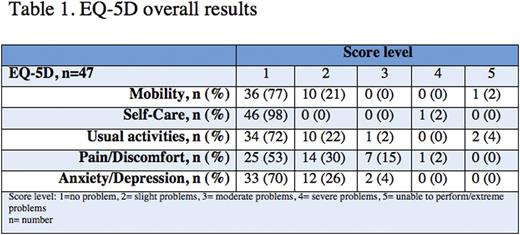Introduction:
Over the last decade transplant programs have seen a significant increase in the median age of autologous hematopoietic stem cell transplant (AHSCT) recipients (McCarthy et al. 2013).We recently demonstrated thathigh-dose chemotherapy (HDT) followed by AHSCT was safe and well tolerated in elderly patients withchemosensitivenon-Hodgkin lymphoma (NHL) regardless of their age. Furthermore, we wanted to assess if the survival benefits conveyed by transplantation were equally associated with the maintenance of a good quality of life (QoL).
Method:
This single-center, research and ethic committee approved retrospective study, examined QoL of survivors following AHSCT for the treatment of NHL in the elderly. Inclusion criteria were defined as patient aged of 60 years and older who had received an AHSCT for a NHL at our hospital between January 1st, 2008 and January 1st, 2015 and survived. 59 patients from the original cohort of 90 patients met the inclusion criteria. Forty-seven of them (79.7%) participated by completing a survey. Patients were required to sign an informed consent.EQ-5D (Rabin et al. 2001) instrument was usedto assessmobility, self-care, usual activities, pain/discomfort and anxiety/depression.In addition, FACT-BMT (McQuellonet al. 1997)questionnaire was also used to assessfive different areas: physical well-being (PWB), social/family well-being (SWB), emotional well-being (EWB), functional well-being (FWB) and BMT specific concerns. The different scores were correlated to the type ofconditioning regimen, gender, age sub-groups (<65 or 65 and over), HCT-CI score,Karnofskyindex and disease status at transplant and relapse.
Results:
The median time from AHSCT was 50 months (ranges 17-96). A total of 7 (15%) patients were in relapse when surveyed. Results from theEQ-5Dquestionnaire (table 1) showed that 28 patients (60%) were fit with no or one domain of impairment.Only 4 patients (9%) reported impairments in 4 or 5 domains. 46 patients (98%) were having no or slight problem walking. Almost all patients (98%) reported being able to take care of themselves. Experiencing pain was the most frequently reported issue with 19% of patients being affected by moderate to severe pain. Interestingly, 96% of patients reported having no or slight problem related to anxiety or depression. LowerKarnofskyindex at diagnostic was associated with impaired mobility (p = 0,03) and self-care (p = 0,03). Anxiety was worse for patients in relapsed after transplant (p=0,001). Other comparators did not impact on any of these outcomes.
FACT-BMT questionnaire results (Table 2) showed that PWB, SWB and EWB were good while FWB was more variable. Relapse was associated with impaired EWB (p=0,05) as well as BMT specific concerns (p=0,18) and lower FACT-BMT results (p=0,035). Other comparators did not impact on any of these outcomes.
Conclusion:
This study demonstrates that physical, social and functional well-being are maintained and very good for elderly patients following AHSCT. LowKarnofskyscore prior transplant is a predictor of disability following AHSCT. Relapse following AHSCT represents the most significant challenge and impediment to maintain a good QoL. Elderly patients are, once more, no different from younger ones in their capacity to regain their QoL following transplantation. For this reason, elderly patients should not be denied from transplantation solely based on their age.
No relevant conflicts of interest to declare.
Author notes
Asterisk with author names denotes non-ASH members.



This feature is available to Subscribers Only
Sign In or Create an Account Close Modal